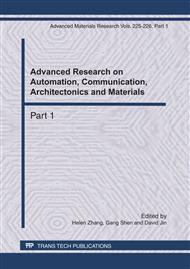[1]
J. L. Farh, C. Lee and C. C Farh: Task conflict and team creativity: A question of how much and when. Journal of Applied Psychology. Vol. 95(2010), p.1173.
DOI: 10.1037/a0020015
Google Scholar
[2]
Gersick C.J.G.: Time and transition in work teams: Toward a new model of group development. Academy of Management Journal. Vol. 31 (1988), p.9.
DOI: 10.2307/256496
Google Scholar
[3]
Levine J.M. and Moreland R.L.: Progress in small group research. Annual Review of Psychology. Vol. 41(1990), p.585.
Google Scholar
[4]
IlgenD.R., Hollenbeck J.R., Johnson,M. and Jundt,D.: Teams in organizations: From input –process-output models to imoi models. Annual Review of Psychology. Vol. 56(2005), p.517.
DOI: 10.1146/annurev.psych.56.091103.070250
Google Scholar
[5]
Ute R. Hu¨lsheger, Neil Anderson and Jesus F. Salgado: Team-Level Predictors of Innovation at Work: A Comprehensive Meta-Analysis Spanning Three Decades of Research. Journal of Applied Psychology. Vol. 94 (2009), p.1128.
DOI: 10.1037/a0015978
Google Scholar
[6]
Stewart G.L.: A meta-analytic review of relationships between team design features and team performance. Journal of Management. Vol. 32 (2006), p.29.
DOI: 10.1177/0149206305277792
Google Scholar
[7]
De Jong, J. P. J., and Den Hartog, D. N.: Determinanten van innovatief gedrag: Een onderzoek onder kenniswerkers in het MKB(Determinants of innovative behavior: A study with knowledge workers). Gedrag en Organisatie. Vol. 18 (2005), p.235.
DOI: 10.5117/2005.018.005.001
Google Scholar
[8]
Cohen S.G. and Bailey D.E.: What makes team work: Group effectiveness research from the shop floor to the executive suite. Journal of Management. Vol. 23 (1997), p.239.
DOI: 10.1177/014920639702300303
Google Scholar
[9]
Aelita Skarzauskiene: Managing complexity: systems thinking as a catalyst of the organization performance. Measuring Business Excellence. Vol. 14(2010), p.49.
DOI: 10.1108/13683041011093758
Google Scholar
[10]
Chan, D.: Functional relations among constructs in the same content domain at different level of analysis: A typology of composition models. Journal of Applied Psychology. Vol. 83 (1998), p.234.
DOI: 10.1037/0021-9010.83.2.234
Google Scholar
[11]
Bono, J. and Judge, T.: Self-concordance at work: toward understanding the motivational effects of transformational leadership. Academy of Management Journal. Vol. 46 (2003), p.554.
DOI: 10.2307/30040649
Google Scholar
[12]
Yu J.Y. and He X.H.: Data analysis and the application of SPSS. Beijing: Posts & Telecom Press . (2003). (in Chinese).
Google Scholar


